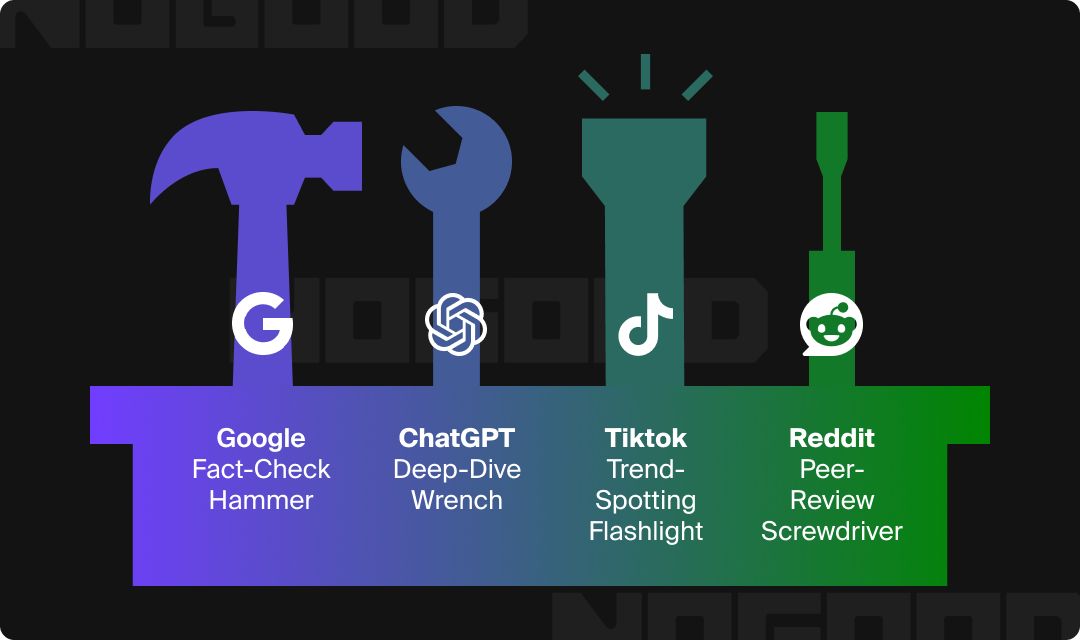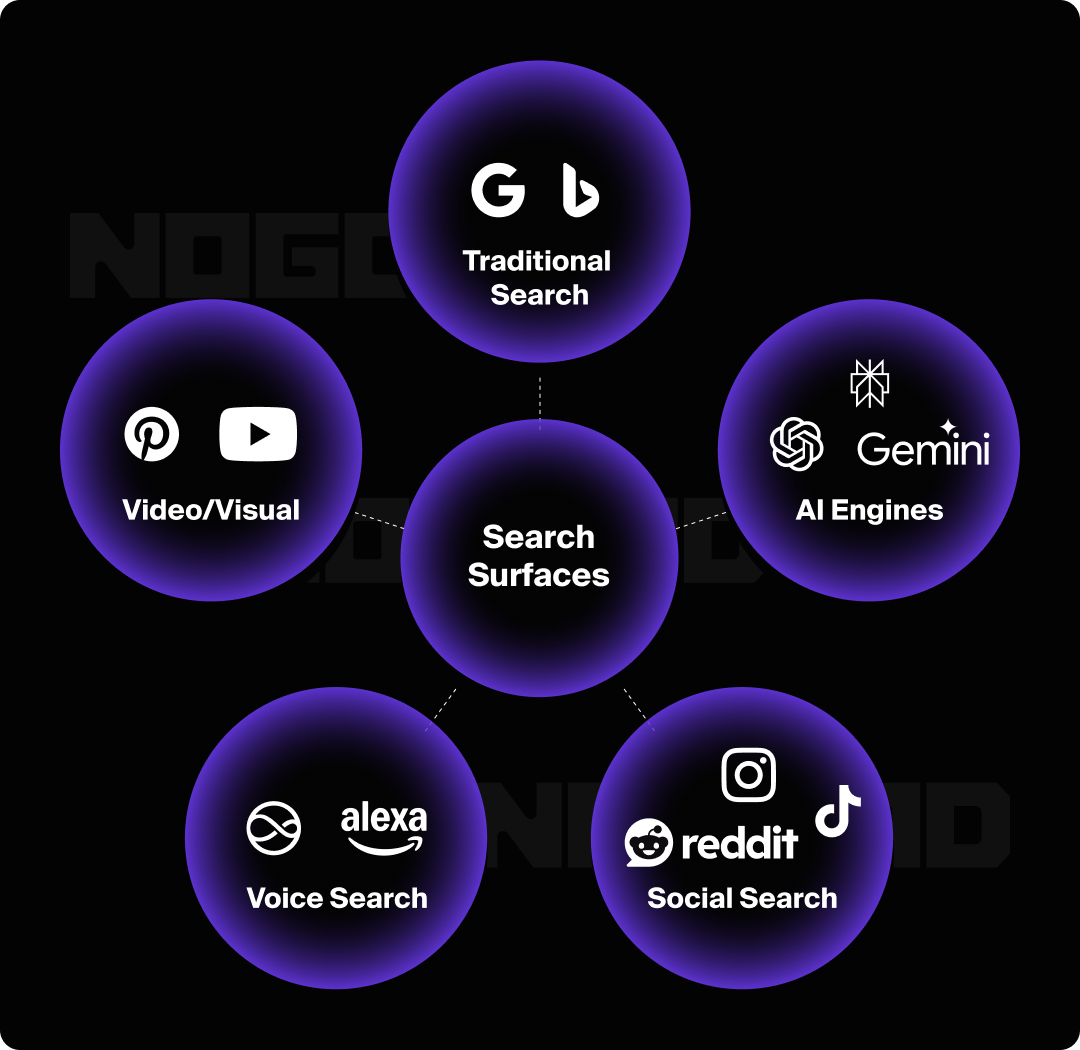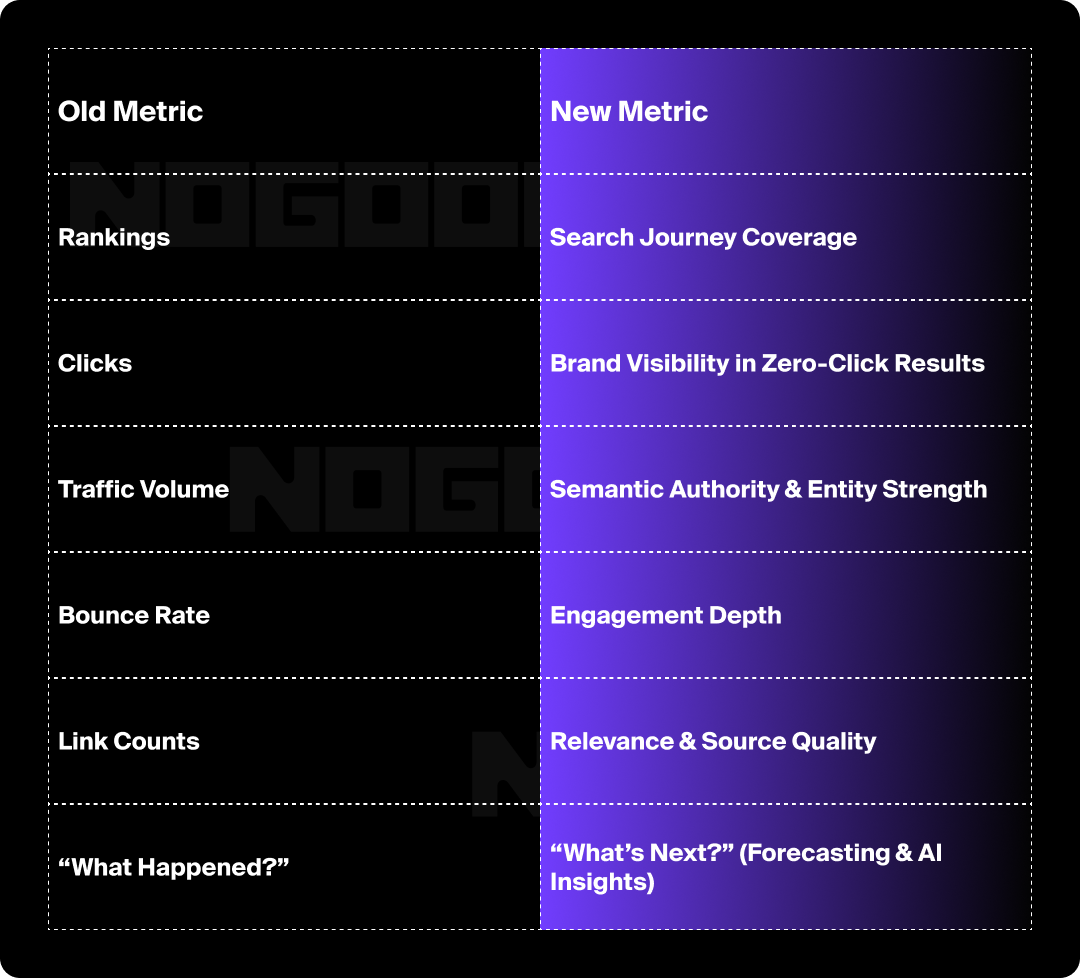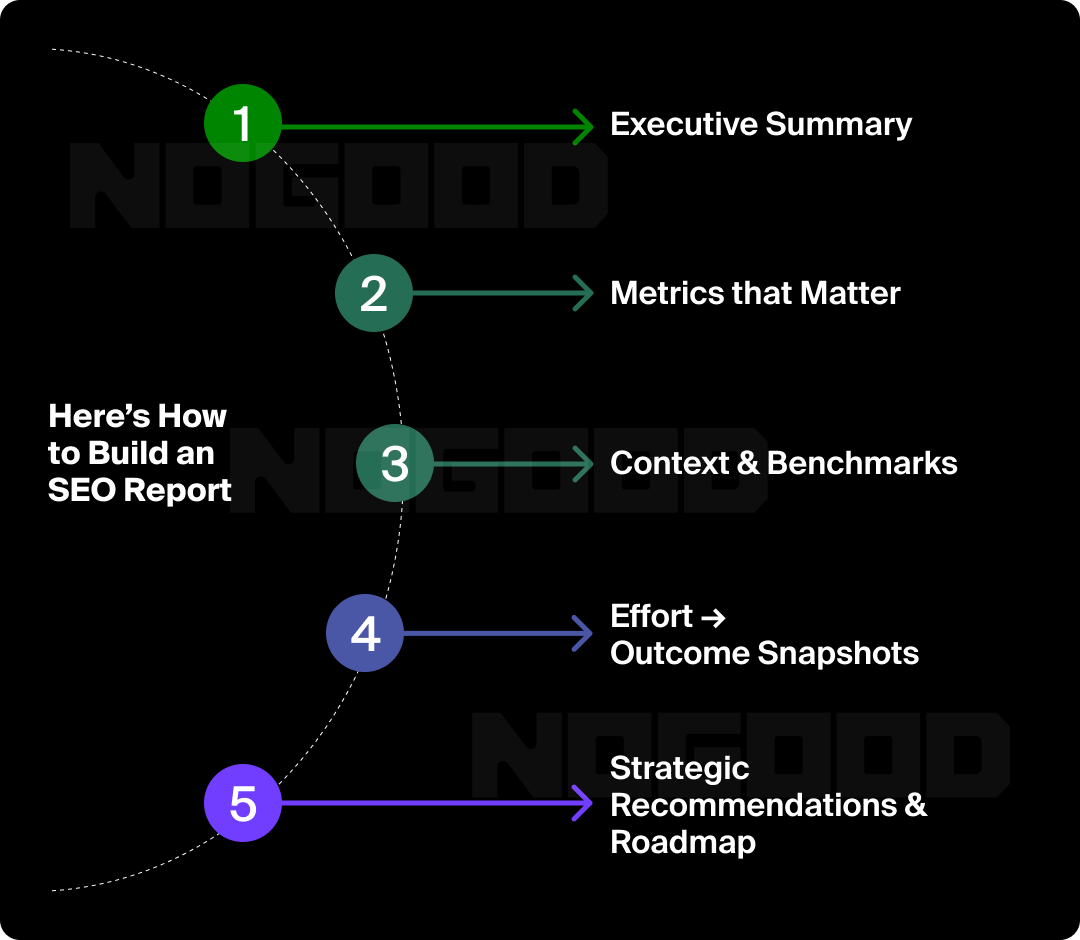SEO as we know it is changing. That means your reporting methodology should, too. With AI search taking over, the metrics that mattered before (like clicks and click-through rate) are being subbed in for AI-friendly, zero-click alternatives.
In 2025, search engines are no longer just finding pages; they’re giving away answers outright. Whether it’s in the LLM of your choice (I’m partial to ChatGPT), Google’s AI Overviews, featured snippets, or People Also Ask boxes, brands are increasingly losing out on website clicks, even when they dominate search results.
At the end of 2024, a survey found that 80% of consumers resolved 40% of their search queries without clicking any links. But does this mean RIP to SEO? Of course not! It just means we need to reframe our SEO reporting for a world where visibility comes without clicks.
So how do we redefine “SEO success” in the era of AI search? Through new KPIs, dashboard expansions, and tools to translate search presence into brand value.
Why SEO Reporting Still Matters

AI search, disappearing clicks, and algorithm shifts—oh my!
I promise, upgrading your SEO reporting is still worthwhile. If a business is investing in organic visibility, you can bet your bottom dollar that SEO still counts for something.
Here’s why:
Turning Complexity Into Clarity
Search is more fragmented than ever. Today’s users treat search like a toolbox, reaching for the platform that best fits the job.
Need a fast fact? Google. A nuanced explanation? ChatGPT. Peer reviews or visual inspiration? TikTok, Reddit, YouTube. The platform a user chooses depends entirely on the question they’re asking, which means your brand’s visibility can no longer be measured in just one place.
Modern SEO reporting is the only way to understand how and where your audience is finding (or missing) you.
Tying SEO to the Stuff the C-Suite Cares About
Let’s be real, nobody’s doing SEO just for rankings. The best reports go beyond page positions to show how organic search is pulling its weight across your business. When done right, SEO reporting connects the dots between what you publish and what actually moves the needle:
- Revenue growth
- Lead generation
- Customer acquisition
- Brand visibility
Instead of celebrating traffic for traffic’s sake (talk about a vanity metric), smart reports show how that visibility turns into pipeline, purchases, and brand equity. It’s not just about “how many people came”, it’s about what they did next.
Flagging Problems (Before They Cost You)
When SEO performance tanks, it doesn’t start with a bang; it begins with a slow leak. A buried 404 here, a forgotten redirect there, a key page slowly slipping in rankings. If you’re not reporting on the right things, you’ll miss the early warning signs.
SEO reporting acts like a dashboard warning light: flagging drops in visibility, crawl issues, content decay, and site health risks before they become expensive problems. For decision-makers, this means less guesswork and more time to course-correct.
Making a Stronger Case for Budget, Buy-In & Bold Moves
Trying to make the case for a website redesign? Need more budget for content or tools? A good SEO report arms you with proof, not opinions.
By spotlighting what’s working, what’s lagging, and what’s driving growth, reporting gives leadership a clear rationale to invest, prioritize, and act. It’s not just data, it’s your best pitch deck!
TL;DR: SEO reporting isn’t just for tracking. It’s your visibility engine, risk radar, and business case builder rolled into one. And in a world where the rules of search keep shifting, that kind of clarity is more valuable than ever.
The 2025 Landscape: AI, Zero-Click Search & the Vanishing Click
If SEO in 2020 was about getting the click, SEO in 2025 is about earning the mention (and hoping you still get the click anyways).
Search engines have evolved from directories into answer machines, and in many cases, they’re giving users exactly what they need, without ever sending them to your site. Welcome to the era of zero-click search and AI-generated results.
The Rise of Answer Engines

- AI tools like Google’s AI Overviews, ChatGPT, Perplexity, and You.com deliver instant, multi-source answers, no click required.
- Voice assistants like Alexa and Siri are handling more informational queries directly.
- Social platforms like TikTok, Reddit, and Instagram are becoming the go-to search engines for Gen Z and younger Millennials (some even integrating their own versions of Google’s AI Overview), especially for product discovery, how-to content, and trend validation.
These aren’t just distractions; they’re part of the new search ecosystem, where discovery happens in feeds, not just SERPs.
What This Means for Your Metrics
Even if your content is the reason someone got the answer they were seeking, you might not see conversions, sessions, or even pageviews reflected in your reporting dashboard.
No need to cry about it though! Seriously, wipe those tears. Your brand is showing up, your analytics just don’t always reflect it. In the new search world, visibility ≠ traffic, and traffic ≠ success. This means marketers need to start asking better questions, like:
- Are we showing up in AI Overviews?
- Are we being cited in generative responses?
- Are we maintaining authority across fragmented platforms?
(Shameless plug, but Goodie is a tool that can answer those questions for you).
The Shift From Clicks to Presence
Whether you work in in-house marketing or at an agency, you’ve probably experienced a CEO or CMO panicking and obsessing over traffic and click dips. But no need to fear! We just need to start measuring where (and how) content is being surfaced across the new search ecosystem.
SEO reporting needs to evolve from counting visits to ✨capturing influence✨because the value of a search impression doesn’t just live in a click anymore.
New Metrics That Actually Matter

Still reporting on traffic, rankings, and bounce rate alone? That’s like measuring your brand’s success by how many people walked past your store; not how many remembered it, engaged, or came back.
The search game has changed, and so must your KPIs. Here’s how you should be rethinking SEO metrics to align with a world of AI answers, multi-platform search, and shrinking clicks:
Rankings → Search Journey Coverage
Ranking #1 means less if you’re only visible at one stage of the funnel. Instead, ask:
- Are we covering the full buyer journey across topic clusters?
- Do we own informational, commercial, and branded queries?
Report on: Topic depth, internal linking coverage, and query intent mapping.
Clicks → Brand Visibility in Zero-Click Results
You might not get the click, but your content might still power the answer.
Report on:
- Inclusion in AI Overviews (manual spot checks or by leveraging tools like Goodie)
- Featured snippet ownership
- Appearances in “People Also Ask,” knowledge panels, and visual results
Traffic Volume → Semantic Authority & Entity Strength
In the age of LLMs, it’s not just what you say, it’s whether machines trust what you’re saying.
Report on:
- How often your brand and its content are cited across AI tools
- Schema health and entity markup
- Topical authority across clusters
Bounce Rates → Engagement Depth
Bounce rate is a blunt metric. In 2025, engagement is what signals quality to both humans and machines.
Report on:
- Scroll depth
- Time on page
- Return visits or multi-touch journey behavior
Link Count → Relevance & Source Quality
Backlinks still matter, but not all links are created equal. Focus on links that pass relevance, authority, and trust signals.
Report on:
- Domain Authority / Page Authority (DA/PA)
- Anchor text context
- Topically aligned referring domains
“What Happened?” → “What’s Next?”
The best SEO reports don’t just describe! They predict. Thanks to AI SEO reporting tools, we can now surface:
- Content decay risk
- Keywords likely to drop or rise
- Competitor movements in real time
Bonus: Use predictive tools or AI summaries to forecast performance shifts.
The Bottom Line: In 2025, the smartest SEO teams (like us at NoGood 💁) aren’t just counting clicks; we’re measuring influence, authority, and presence across a fragmented, AI-powered search ecosystem. Modern reporting reflects the new rules of visibility.
How to Build an Executive SEO Report in 2025
Nobody needs another 10-page PDF full of numbers, tables, and charts and missing all of the context.
A great SEO report isn’t just a data dump; it’s a decision-making tool. It highlights wins, flags risks, and recommends next steps in plain language. It connects SEO performance to business outcomes. And most importantly, it saves your stakeholders’ time.
Here’s how to build an SEO report that leadership teams will actually read and be willing to act on.

Start With the “So What?”
Kick off your report with an executive summary. Think of this as your TL;DR:
- What happened?
- Why does it matter?
- What should we do next?
Use visuals, bullets, and a narrative summary to make insights scannable and stakeholder-friendly.
Show the Metrics That Matter
Ditch vanity metrics (seriously). Focus on KPIs that tie to business performance:
- Search visibility across AI + SERPs
- Organic contribution to leads, revenue, or pipeline
- Top-performing content by conversions or engagement
- Content gaps and growth opportunities
- Technical site health and associated risks
Pro tip: Group data by strategic objective (e.g., “Lead Gen,” “Brand Authority,” “Content Expansion”), not just by channel or tool.
Add Context With Benchmarks & Trends
Don’t just show what changed, explain whether that change is good, bad, or expected.
- Compare performance by period (MoM, QoQ, or YoY)
- Add industry benchmarks (when possible)
- Show change in visibility across AI modules or SERP features
- Track content performance over time, not just in isolation
Tie Effort to Outcome
Help whoever’s reading your report connect the dots:
- “We updated our product landing pages → CTR improved 18%”
- “We fixed 1,200 broken internal links → indexation improved, and traffic rebounded”
Cause-and-effect storytelling makes SEO feel like a strategic win, not a mystery box.
Use Tools That Support Executive-Friendly Reporting
Here are our top tools for building modern SEO reports:
- Looker Studio (custom dashboards pulled in from GA4, GSC, Ahrefs, etc.)
- SE Ranking or DashThis (for automated, agency-style visuals)
- Goodie (to track AI Overview, generative search, and AI shopping visibility)
- Notion, Airtable, or Google Slides (for easy collaboration and delivery)
- ChatGPT or Gemini (for summarizing trends into plain English)
Include a Roadmap or “What’s Next” Section
Don’t leave your report as a rearview mirror. End with forward momentum:
- Priority actions (with timelines or owners)
- Opportunities for optimization or investment
- Forecasts or predictions for key KPIs
Executive Tip: If it’s not actionable, why report it? The best SEO dashboards don’t overwhelm; they focus, align, and move things forward.
SEO Reporting Tips for Different Stakeholders
Not every audience needs the same data or the same level of detail. An SEO report that wows your content team might completely lose your CFO. In 2025, tailoring your reporting to the stakeholder isn’t a nice-to-have; it’s becoming an expectation.
Here’s how to make sure every team gets what they need (and nothing they don’t):
For Executives: Focus on ROI, Not Rankings
Executives care about how SEO supports business growth, not how many blog posts ranked in the top three positions in the last month.
What to highlight:
- Organic’s contribution to revenue, leads, or pipeline
- Trendlines, not one-off wins
- Budget justification (what SEO delivered, and where opportunity lies)
- Clear “What’s Next” section to support decisions
Pro tip: Include a narrative summary or use AI to generate a 60-second “State of SEO” brief.
For Content Teams: Show What’s Working & What Needs Work
Writers, editors, and strategists want insights they can take action on.
What to highlight:
- Top-performing content by rankings, CTR, and engagement
- Keyword opportunities and content gaps
- Pages that are declining and need optimization
- Internal linking suggestions and topic cluster health
To go above and beyond, add a content-specific dashboard or Google Sheet with filters for quick wins.
For Clients or Non-Technical Stakeholders: Keep It Clear & Jargon-Free
If you’re working with clients or stakeholders who don’t live in SEO tools every day, your report should educate and empower, not confuse.
What to highlight:
- High-level wins (“We’re now ranking for X,” “Traffic from Google increased 24%”)
- Easy-to-understand visuals
- Business impact (more visibility, leads, or conversions)
- What you’re doing next (so they know you’ve got a plan)
Pro tip: Swap SEO jargon for business language: say “pages that bring in traffic” instead of “high-value URL clusters.”
The takeaway? Same data, different delivery. When everyone gets the insights that matter to them, SEO becomes a shared win, not just an SEO team win.
The Future of SEO Reporting: What’s Next?
SEO reporting is no longer just a monthly recap. It’s evolving into a real-time command center for brand visibility in an AI-dominated search world. As platforms, user behavior, and search interfaces continue to shift, here’s what’s on the horizon:
1. Predictive, Not Just Descriptive
Reporting will shift to predictive analytics; from “here’s what happened” to “here’s what’s likely next.”
Expect dashboards to incorporate machine learning models that flag:
- Pages at risk of ranking drops (content decay, keyword cannibalization, link loss)
- New keyword opportunities based on rising search intent
- Forecasts for traffic or visibility based on current momentum
Why it matters: This allows businesses to be proactive, not just reactive, with content, budget, and dev resources.
2. Real-Time AI Summaries & Recommendations
Forget digging through 20 charts. AI is already producing human-readable summaries on demand:
“This month, branded search impressions rose 22% due to the updated homepage. However, your product pages dropped from positions 3 to 6, likely due to newer competitors and outdated meta content.”
Bonus: These summaries will be tailored by role, with one version for the CMO and another for your SEO analyst.
3. Answer Engine Optimization (AEO) Metrics
As generative search continues to rise, expanded reporting will become the standard:
- LLM citation tracking (Are we being mentioned in AI tools like ChatGPT, Perplexity, and Gemini?)
- Entity salience (How confidently are we associated with key topics?)
- Schema visibility (Are we structured enough to be picked up?)
New tools have and will continue to emerge just to monitor and optimize this kind of search exposure.
4. Cross-Platform Search Visibility
SEO will no longer mean “Google visibility”. Brands must track presence across:
- Google Search
- TikTok Search
- YouTube
- ChatGPT, Perplexity, and other answer engines
Unified dashboards will surface how often you appear, how users engage, and what formats are most effective, from articles to short-form video.
5. Storytelling-First Reporting
Expect more reports to be built like content, not spreadsheets. Think:
- Visual-first dashboards
- Narrative blocks for context
- Embedded multimedia (heatmaps, scroll maps, and video explainers)
- Modular reports by department
This shift will make reports easier to digest and more influential across the org.
The future of SEO reporting isn’t more data, it’s more clarity. In a world of AI interfaces, zero-click journeys, and shifting user habits, the teams that win are the ones that report smarter, act faster, and tell better stories with their search data.
Long Live the Report!
Get ready to spice up your reports; SEO reporting is no longer just about tracking rankings or logging clicks. It’s about making smarter decisions in a search landscape that’s shifting by the week.
With AI reshaping how people discover, interact, and buy, the brands that succeed won’t be the ones obsessing over traffic dips; they’ll be the ones tracking visibility, authority, and influence across every platform their audience uses to ask questions.
Whoever you’re reporting to, the goal remains the same: translate complexity into clarity. Show what’s working, where the risks are, and what’s next, because in a zero-click world, a clear story beats a cluttered spreadsheet every time.






